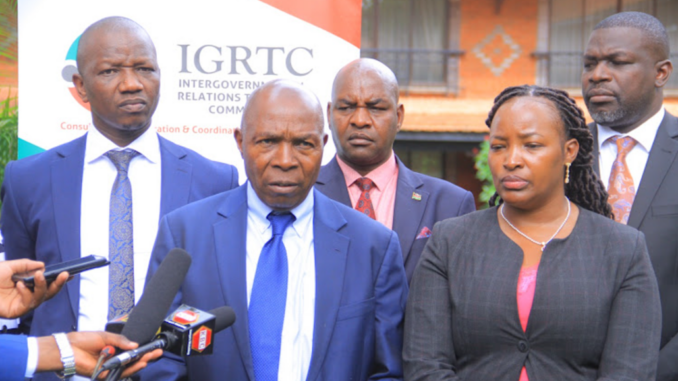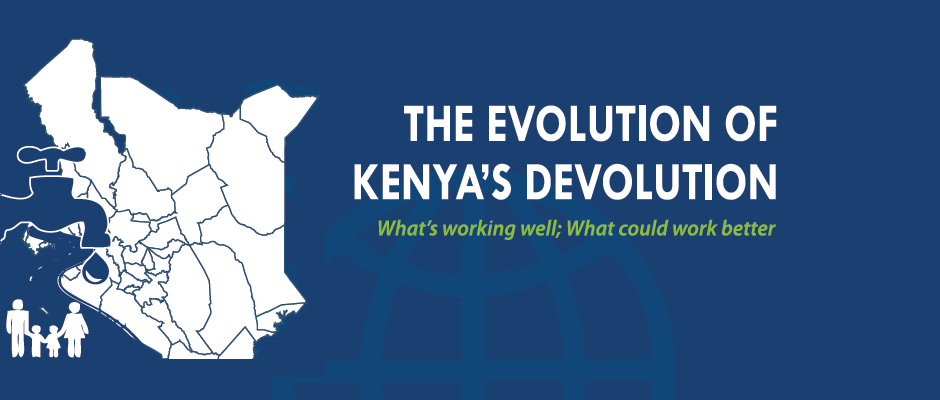
While the Constitution of Kenya (2010) provides the framework for inclusive, devolved governance, there are many challenges to its effective implementation including: resistance to change by the power and economic elites; legacy of disrespect for the Constitution or lack of constitutionalism; capacity of the two levels of government to effectively implement many of the provisions of the Constitution; turf wars between and among government institutions; cultural resistance to some of its human rights provisions such as gender equality; weak policy formulation and implementation; corruption and impunity especially by the power wielders which undermines the ability of government to deliver services and a general lack of or inadequate knowledge about the Constitution which hinders effective public participation needed for its implementation.
A recent publication by Kenya’s Intergovernmental Relations Technical Committee is part of a series of dialogues on constitutionalism, examines some of the issues that should be addressed for the effective practice of constitutionalism.
Successes in Implementation
Among the early steps taken to facilitate the implementation of the Constitution was the establishment and consequent operationalization of the various institutions needed to guide different aspects of the Constitution.
Among the institutions established are the Commission for the Implementation of the Constitution (CIC), the Commission on Administration of Justice (CAJ), the Police Service Commission, the Commission on Revenue Allocation , the National Land Commission (CRA) the Kenya National Commission on Human Rights (KNHCR). The second major activity aimed at facilitating the implementation of the Constitution was the enactment of laws required to give effect to the Constitution. These laws were identified by the framers of the Constitution, listed in schedule five of the constitution. The Constitution provides time-lines within which these laws were to be passed by parliament. The required laws have all been enacted except for one (the law intended to ensure that no more than two-thirds of parliament is of the same gender).
The other key constitutional implementation activity was the establishment of relevant institutions and systems. This was particularly urgent for county governments. County governments each comprising executive and legislative branches were established following the general elections held in March 2013. On coming into existence county governments embarked immediately on putting in place systems and structures to facilitate the carrying out of their mandate and functions. The systems that were established included financial systems. The county governments also put in place County Public Service Boards to handle the human resource function of counties as required by the County Governments Act 2012. Each county government has its own Public Service Board. The County Assemblies have also been established and are enacting laws required to give legal backing to county government functions. Each County Assembly has also established a County Assembly Service Board. These Boards have similar functions as the Parliamentary Service Commissions. To facilitate intergovernmental coordination a body known as the Intergovernmental Relations Coordinating Summit was established. It comprises the President as chairman and all the 47 governors.
Challenges of Implementation
Based on the above, one can argue that on the whole the implementation of the Constitution of Kenya 2010 has been on course. There are, however, a number of challenges that have been experienced in this process.
One of them has been the slow process of putting systems in place especially for county governments. This could be explained by the fact that this is a new system of governance and the county managers lacked the experience necessary to get things going. This has now been largely accomplished.
Secondly was the fact that the county governments lacked staff of their own. They relied on staff from the national government. These were made up of former central government employees who were performing functions that were devolved to county governments upon the promulgation of the Constitution. This posed a number of challenges. First was that it has taken a bit of time to get national government staff to report and start work at the counties. Secondly, the seconded staff was uncertain about their future at the county government level. In any case they were not sure where their loyalty lay. Many felt they were loyal to the national government. Indeed, there were cases where governors complained that they were frustrated by the seconded staff many of whom tended to receive instructions from the national government while ignoring instructions from county governments.
A related challenge arose from the fact that there were several categories of staff at the county government. In addition to the seconded staff from the national government, there was staff from the defunct local authorities. The County Government Act 2012 provides that all staff of former local authorities automatically became employees of the county government. This means that, for example, all local government employees in the local authorities of former Siaya district automatically became staff of the Siaya county government. The third category of staff at the county government level was those seconded to the counties by the now defunct Transition Authority (TA). The TA was established by the Transition to Devolved Government Act, 2020 to, among other functions; facilitate the transition from the centralized to the devolved system of government. As part of this mandate TA seconded some employees to assist county governments get started.
The relationship among these three categories of staff was not always harmonious or collegial. This was not good for the functioning of the county government and therefore the implementation of the Constitution. Of particular concern was the fact that the staff inherited from the local authorities earned much higher salaries than those from the central government despite the low academic qualifications the former local authority staff had. They moved to their new employer with the high salaries they inherited from their previous employer. This created a feeling of unfairness which affected the morale and performance of the employees seconded from the central government as well as those seconded to the county governments by the TA. Part of the problem was the failure to manage the transition of staff well. It took a long time before the Public Service Commission began to work with the County Public Service Boards and other stake holders to address the challenge. This has not augured well for the implementation of devolution in particular and the Constitution generally.
The Rule of Law and Impunity
The establishment of institutions, structures and the putting in place of systems and the passage of legislation to facilitate implementation is perhaps the easier part compared to the challenge of constitutionalism. Constitutionalism refers to the respect for and compliance with the constitution and exists when leaders and citizens act in accordance with the Constitution. It requires respect for the rule of law. One of the reasons why African governments tended to be dictatorial especially in the period before the current wave of democratization was precisely because their leaders did not respect the Constitution. Many of them ruled as if the constitution did not exist. Kenya suffered from this problem in the past at least three ways. First was the practice after independence of amending any provision in the Constitution that constrained the powers of the leaders and especially that of the executive. Secondly, the executive on many occasions did not find it difficult to ignore or overlook the Constitution and act arbitrarily. This partly contributed to the demands for a new constitutional dispensation. Thirdly was the culture of impunity: powerful people–especially in government– violated the constitution and broke the law and got away with it as no action was taken against them.
The implementation of the 2010 Constitution unfortunately has also witnessed attempts to either ignore or amend some of its provisions. There was also a case in 2015, for example, when the President attempted to ignore court orders on police recruitment. He eventually bowed to pressure from CIC and other oversight institutions and allowed the law to take its course. This failure to respect the constitution and the rule of law and the culture of impunity remains a major challenge to the implementation of the constitution. Efforts must be made to inculcate and build a culture of constitutionalism among Kenyans and their political leaders if the country hopes to fully and effectively implement the Constitution. The focus should therefore be on building a constitutional culture.
Turf Wars among Different Arms of Government
The above challenges have been compounded by institutional wars including conflicts between the different arms of government. The most common of these wars has been that between the senate and the national assembly. The war between these two law-making bodies has essentially been over jurisdictional disputes with the two accusing each other of not respecting the other or of interfering with each others’ jurisdiction.
There have also been conflicts between county assemblies and governors. In the case of Makueni County, the conflict was so serious that a Commission, in accordance with the constitution, was set up to advice the president on whether or not the county government should be dissolved. In Embu County, the county assembly attempted to impeach the governor. Similar attempts were made in Muranga and Kericho counties, just to mention a few. The point is that these conflicts undermined the functioning of the county governments and therefore the smooth and effective implementation of the Constitution.
Conflicts have also been recorded between the national government and the county governments. These conflicts have also revolved around jurisdictions. The case that comes to mind immediately is one that occurred when the national government leased modern medical equipment and instructed county governments to accept them and install them in hospitals managed by county governments.
This became a major source of conflict between the two levels of government. The county governments objected to the involvement of the national government in the purchase of the medical equipment for two reasons. First the county governments argued that they were not consulted before the equipment was purchased. Article 6(2) of the constitution requires the two levels of government to work in cooperation and consultation. Secondly, county governments argued, and rightly so, that the health function has been devolved to county governments and therefore the national government did not have jurisdiction over the function and consequently could lease the medical equipment for counties. Although counties eventually accepted the equipment, tensions remain over the procurement. The national government’s reluctance to release the county roads to county government has also caused conflict. The conflicts certainly undermine service delivery, a key objective of devolution. They also go counter to the cooperative model of devolution that Kenya adopted when it promulgated the Constitution.
Challenges of Public Participation
Another challenge to implementation relating to constitutionalism has been the tendency by the two levels of governments to overlook constitutional requirements for public participation. The Constitution gives premium to the participation of the people of Kenya in their governance. Leaders and governance institutions are obligated to seek the input of the people in governance decisions. The people should be involved in the making of public policy, legislation and regulations and in the budget making process among other important public decisions on matters that affect their lives.
Unfortunately, the two levels of governments have not been very faithful to this constitutional requirement. There have been complaints by residents of various counties that they are not given opportunity to influence decisions of county governments. The residents of Kiambu County, for example, went to court in 2015 to stop the implementation of a finance law passed by the county assembly on the ground that their views on the finance bill were not sought by the county government. The court agreed with the residents and annulled the law.
A number of reasons have been given by some county governments for not effecting effective public participation. Among them is the cost of organizing and facilitating public participation. Counties argue that the cost of producing documents required for effective participation is often prohibitive and out of reach of counties. Secondly many counties point to the absence of a policy on public participation as a challenge. This has resulted in unstructured and often ineffective public participation in those counties where attempts have been made to have public participation. County governments also observe that in many cases members of the public expect to be offered transport by the county governments to the venues where public participation is to take place. In some extreme cases residents of counties ask to be paid to participate.
Competition between County Assemblies and Executives over Participation
A related challenge regarding public participation is the practice in which the executive and the county assembly invite residents for public participation twice over the same issue. Many county executives blamed the Members of the County Assembly (MCA) for this practice. Residents of some counties also complained about this practice. The practice is costly as it leads to double expenditure on one issue. This is perhaps one of the reasons why county governments find the cost of public participation prohibitive.
County governments would save money if they coordinated these activities in such a way that the executive and the assembly hold joint forums on any one issue. Secondly the practice discourages residents as they wonder why they should discuss the same issues more than once. It can lead to participation fatigue. It must also be pointed out that rural residents are busy people and too many government engineered meetings may cease to be attractive if they interfere with their own schedules.
The question then is why are members of the two arms of government engaged in a practice that is obviously harmful to public participation and therefore to the implementation of the Constitution? Our hypothesis is that it shows a lack of cooperation between the two arms of county government. It could signify a lack of understanding of the fact that the two arms belong to the same government. Some MCAs regard themselves as competitors with the executive arm of government. Indeed, there appears to be a general notion that a legislative arm of government is not part of government. Often we hear even members of the national assembly referring to the executive as the government in a manner to suggest that the assembly is not part of government.
In cases where residents of counties are invited to participate in an issue, their major complaint has been about the technical language and nature of the documents that they are given. They point out that these documents are prepared in such technical language that they do not understand their content. In any case they also observe that the documents are often too long for them to read. Finally, residents complain that usually they are given very short notice about the meetings and that this may explain the low attendance at such meetings. Some even complain about the suitability of the venues where the meetings are held. The result is that the little participation that is undertaken is a mere token. It lacks seriousness. Its impact is therefore minimal.
While the claims by some governors that residents ask to be paid to attend public participation meetings is difficult to verify, they are serious enough to warrant attention. It is only after they have been verified or dismissed that appropriate action can be taken to promote public participation. This would be necessary also because public participation can also serve as a means for civic education.
Many Kenyans, including some political leaders, are not familiar with the provisions of the Constitution. It must be a matter of concern that leaders exhibit poor knowledge of the Constitution. Ignorance of the Constitution is therefore another challenge to its effective implementation. It also undermines constitutionalism as one can only respect and act according to the Constitution if one is familiar with its provisions.
Key Take-Aways
Arising from the above it is clear that one of the challenges to effective implementation of the Constitution of Kenya is poor intergovernmental relations. This arises partly from a misunderstanding of the devolution model adopted by Kenya, resistance to change, power struggles, and failure by some institutions to play their role effectively among other factors. Intra-governmental relations especially relations between county assemblies and county executives are also poor. It is also clear that there is some misunderstanding between the two levels of government over their respective functions. This partly arises from the failure by the TA to undertake functional unbundling and analysis as required by the Transition to Devolved Government Act. Challenges relating to funding have also emerged since implementation began.
Kenya’s experience implementation the devolved 2010 Constitution suggests that transforming a previously centralized governance system into an inclusive, devolved public sector is a process rather than an event. Addressing the implementation challenges that limit the vision of an inclusive, responsive, and accountable public sector requires an in-depth understanding of the challenges being faced, a review of different perspectives, and a commitment to deepening constitutionalism and devolution.
This blog is an excerpt from: Intergovernmental Relations Technical Committee. 2021. Deepening Devolution And Constitutionalism In Kenya: A Policy Dialogue.




